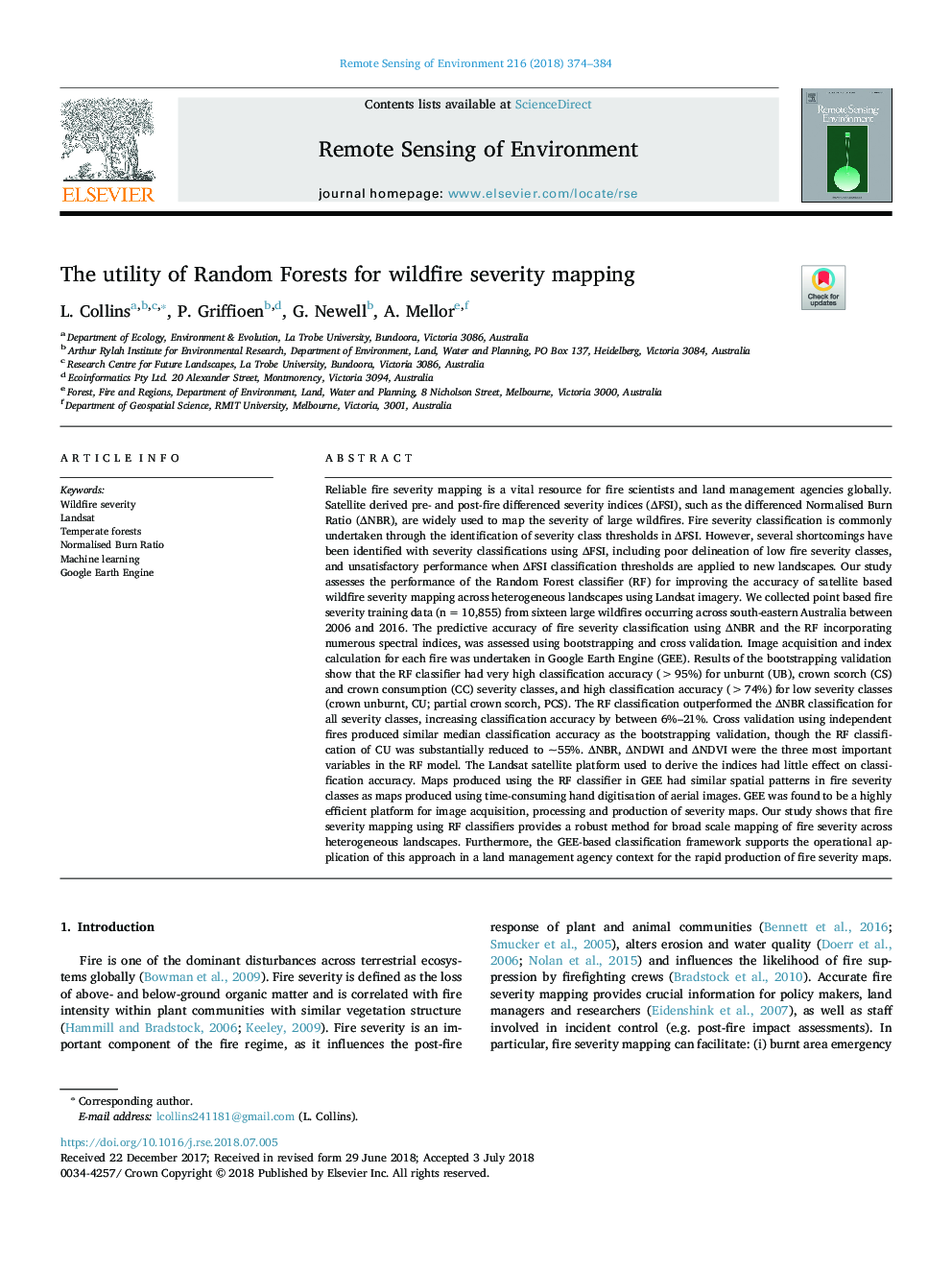| کد مقاله | کد نشریه | سال انتشار | مقاله انگلیسی | نسخه تمام متن |
|---|---|---|---|---|
| 8866423 | 1621184 | 2018 | 11 صفحه PDF | دانلود رایگان |
عنوان انگلیسی مقاله ISI
The utility of Random Forests for wildfire severity mapping
ترجمه فارسی عنوان
استفاده از جنگل های تصادفی برای نقشه برداری شدید آتشفشان
دانلود مقاله + سفارش ترجمه
دانلود مقاله ISI انگلیسی
رایگان برای ایرانیان
کلمات کلیدی
موضوعات مرتبط
مهندسی و علوم پایه
علوم زمین و سیارات
کامپیوتر در علوم زمین
چکیده انگلیسی
Reliable fire severity mapping is a vital resource for fire scientists and land management agencies globally. Satellite derived pre- and post-fire differenced severity indices (âFSI), such as the differenced Normalised Burn Ratio (âNBR), are widely used to map the severity of large wildfires. Fire severity classification is commonly undertaken through the identification of severity class thresholds in âFSI. However, several shortcomings have been identified with severity classifications using âFSI, including poor delineation of low fire severity classes, and unsatisfactory performance when âFSI classification thresholds are applied to new landscapes. Our study assesses the performance of the Random Forest classifier (RF) for improving the accuracy of satellite based wildfire severity mapping across heterogeneous landscapes using Landsat imagery. We collected point based fire severity training data (nâ¯=â¯10,855) from sixteen large wildfires occurring across south-eastern Australia between 2006 and 2016. The predictive accuracy of fire severity classification using âNBR and the RF incorporating numerous spectral indices, was assessed using bootstrapping and cross validation. Image acquisition and index calculation for each fire was undertaken in Google Earth Engine (GEE). Results of the bootstrapping validation show that the RF classifier had very high classification accuracy (>95%) for unburnt (UB), crown scorch (CS) and crown consumption (CC) severity classes, and high classification accuracy (>74%) for low severity classes (crown unburnt, CU; partial crown scorch, PCS). The RF classification outperformed the âNBR classification for all severity classes, increasing classification accuracy by between 6%-21%. Cross validation using independent fires produced similar median classification accuracy as the bootstrapping validation, though the RF classification of CU was substantially reduced to ~55%. âNBR, âNDWI and âNDVI were the three most important variables in the RF model. The Landsat satellite platform used to derive the indices had little effect on classification accuracy. Maps produced using the RF classifier in GEE had similar spatial patterns in fire severity classes as maps produced using time-consuming hand digitisation of aerial images. GEE was found to be a highly efficient platform for image acquisition, processing and production of severity maps. Our study shows that fire severity mapping using RF classifiers provides a robust method for broad scale mapping of fire severity across heterogeneous landscapes. Furthermore, the GEE-based classification framework supports the operational application of this approach in a land management agency context for the rapid production of fire severity maps.
ناشر
Database: Elsevier - ScienceDirect (ساینس دایرکت)
Journal: Remote Sensing of Environment - Volume 216, October 2018, Pages 374-384
Journal: Remote Sensing of Environment - Volume 216, October 2018, Pages 374-384
نویسندگان
L. Collins, P. Griffioen, G. Newell, A. Mellor,
